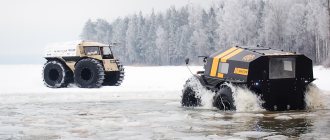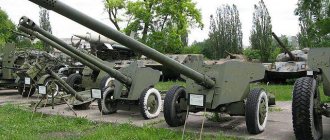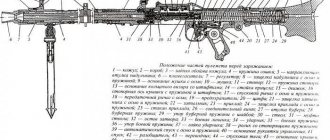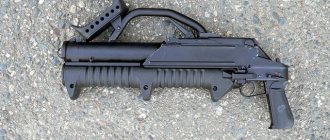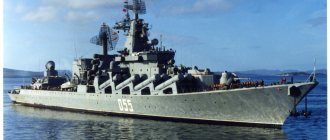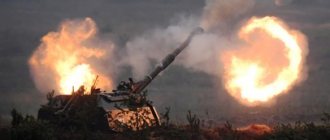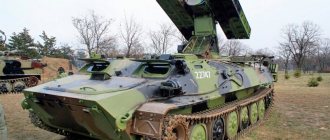Artillery is the god of war, so it was and remains so today. In a large-scale war, the use of artillery is irreplaceable and the outcome of the battle largely depends on its action. Russian design thought does not stand still - in 2013, a new artillery mount 2S35 self-propelled guns Coalition was presented, the performance characteristics of which corresponded to our times.
See also the article Self-propelled artillery mount "Msta-S" 2S19
Artillery mount coalition-SV
| Meaning | Index |
| Crew (persons) | 3 |
| Developer | Central Research Institute "Burevestnik" |
| Gun type Coalition | Rifled howitzer |
| Engine power (horsepower) | 1000 |
| Additional weapons | KORD machine gun |
| Main gun caliber (mm) | 152 |
History of creation
In 1989, the 152-mm self-propelled howitzer 2S19 “Msta-S” was adopted into service with artillery regiments of motorized rifle and tank divisions of the Soviet Army. In terms of its characteristics at the time of adoption, it approximately corresponded to its foreign counterparts, however, already in the early 1990s, NATO member countries adopted the Joint Ballistic Memorandum of Understanding
)[13], which defined a new standard for 155-mm howitzers and set the maximum firing range for high-explosive fragmentation shells at 30 km, and for active-reactive shells at 40 km.
2S33 “Msta-SM”
began (in some sources the index 2S19M is given).
In parallel with the work on modernizing the Msta, the 3rd Central Research Institute conducted research on the issue of further unification of the artillery armament of self-propelled howitzers with sea-based systems, and the Burevestnik Central Research Institute was exploring the possibility of creating a three-barreled artillery complex. Due to the collapse of the USSR and the difficult financial situation of Russia, work was stopped, but already at the beginning of 2002, under the leadership of chief designer Rogov A.P., department No. 0514 of the Nizhny Novgorod Central Research Institute "Burevestnik"[17] designed a model of a multifunctional promising combat module, armed with a double-barrel promising artillery system. As a result of the successful demonstration of the developed module, it was decided to develop and manufacture an experimental model of a new artillery system within two years. By March - April 2003, the optimal designs of the cradle, clip, guides and piston bolt of the gun were designed and accepted for further work[14][17].
After final approval, production of the weapon began. JSC Motovilikha Plants manufactured parts for the barrel and bolt group and the cradle, while TsKB Titan manufactured the pneumatic delivery system for projectiles. In July 2003, the design departments of the Burevestnik Central Research Institute began constructing a test bench for firing tests based on the B-4 towed howitzer. In June - July 2004, the assembly and debugging of the stand was completed, and by September, test results were received that confirmed the correctness of the design solutions of the artillery system. Simultaneously with the stand based on the B-4 howitzer, a mobile complex stand was manufactured at the Ural Transport Engineering Plant, which was a 2S19 self-propelled gun with a double-barreled gun installed instead of the 2A64 howitzer. This stand also passed tests that confirmed the operability of the design of the loading mechanisms of the future promising self-propelled guns. In addition to the planned double-barreled version (called “coalition” due to the connection of the two barrels), a conventional single-barrel version of the gun was also manufactured and tested, placed on the chassis of the 2S5 self-propelled gun. Based on the results of the analysis, it was subsequently decided to abandon the double-barrel scheme, since the single-barrel version had greater reliability of the mechanisms and a lower price [4]. Despite the failure of the approximately ten-year development of the “coalition,” the name had already been accepted and therefore went to a conventional self-propelled gun, the development of which continued. The resulting developments formed the basis of the development work under the name “Coalition-SV” (GRAU index - 2С35
)[17][18].
Officially, work on the creation of the 2S35 began in 2006[19]. In 2011, the stage of issuing working design documentation for wheeled and tracked versions of the system, as well as a transport-loading vehicle for them, was completed[20]. By 2013, the Ural Transport Engineering Plant produced the first two prototypes of the Coalition-SV self-propelled guns, and in 2014 a series of 10 2S35 units was delivered, which took part in the anniversary Victory Parade on Red Square[21].
On March 11, 2020, Colonel Igor Muginov, on behalf of the Western Military District, announced that by the end of 2020, the first batch of self-propelled guns 2S35 “Coalition-SV” will enter service in the Western Military District [22]
On January 2, 2020, according to media reports citing sources in the Ministry of Defense, during tests the possibility of hitting targets at a range of up to 80 kilometers was confirmed.[23]
In December 2020, the General Director of Uraltransmash announced that the first experimental batch of 2S35 “Coalition-SV” had been manufactured and was ready for delivery to the troops[24]. Taking into account the small batch of already produced vehicles that took part in the parade, it is possible that we were talking about the first vehicles in a completely serial form.
Modifications
In addition to the tracked version of the 2S35 self-propelled guns, a wheeled version is also being developed, designated 2S35-1 “Coalition-SV-KSh”. Unlike the tracked version of the Koalitsiya-SV-KSh self-propelled gun, it is placed on a modified base of the KAMAZ-6560 truck. The main modifications to the chassis concerned the strengthening of the truck frame frame. Like the basic self-propelled gun 2S35, the 2S35-1 has an uninhabited fighting compartment. The crew of the self-propelled gun is located in an armored chassis cabin. Deployment time is up to one and a half minutes. The adoption of the 2S35-1 self-propelled guns was planned for 2020, simultaneously with the basic version[25]. As part of the initiative work carried out by the Central Research Institute "Burevestnik", on the basis of the artillery unit of the self-propelled gun "Coalition" modified by JSC "Motovilikha Plants", an experimental weapon was developed that works on new physical principles, allowing to increase the maximum firing range by 1.5 times. The results obtained during the experimental work determined the future prospects for the development of artillery systems[26]. As stated by the general director of the Burevestnik Central Research Institute, an artillery complex for the Coastal Forces of the Navy will be created on the basis of the Koalitsiya-SV self-propelled howitzer[27].
Performance characteristics (TTX)
The table lists the performance characteristics of "KOalitsiya-SV":
| Index | Meaning |
| Start of operation | 2015 |
| Number of copies released | 12 |
| Armor | Rolled steel armor |
| Caliber (mm) | 152 |
| Ammunition (pieces) | 70 shells |
| Firing range (km) | 70 |
Coalition-SV variant equipped with two main guns
Description of design
The rear part of the turret with a 6S21 turret mounted on the roof
Armored hull and turret
The interspecific artillery complex 2S35 “Coalition-SV” is made according to the turret design. The geometry of the vehicle's body is similar to that of the T-90 tank and is divided into three sections: control, combat and power (engine and transmission) sections. Compared to the T-90 tank, the front part of the hull has been significantly modified to accommodate the control compartment. In the middle of the control compartment is the driver's seat with chassis controls, and to the left and right of it are the positions of the gun commander and gunner, respectively. In the middle part of the hull there is a deserted fighting compartment. The process of forming a shot and loading the gun is carried out in a fully automatic mode. The rotating turret of the self-propelled gun is equipped with a 152-mm 2A88 gun. System 902 grenade launchers are installed on the left and right sides of the turret, as well as on the roof, for setting up smoke screens. In the front and rear parts of the roof there are two warning sensors about laser irradiation of the self-propelled guns. In the stern there is a motor-transmission compartment with a power plant[28].
Armament
Transport-loading machine (TZM) 2F66-1.
The main armament of the 2S35 self-propelled gun is the 152 mm 2A88 gun. A muzzle brake is attached to the muzzle of the 2A88 tube. Loading the gun is modular. The projectile is loaded into the barrel using a pneumatic loading mechanism. The design of the loading mechanism ensures loading of the self-propelled gun at any vertical guidance angle without returning the barrel to the loading line. The shot is carried out by a microwave charge initiation system. Thanks to the applied design of the loading mechanisms on the 2S35 self-propelled gun, a high rate of fire is ensured[28][29]. Despite the fact that some media outlets claim the maximum rate of fire of the 2S35 self-propelled gun is 16 rounds per minute[30], the real rate of fire of the Koalitsiya-SV self-propelled artillery mount is classified, it is only known that it is more than 10 rounds per minute[31] and 1.5 times higher than existing artillery systems[32]. The main ammunition of the 2S35 self-propelled gun includes high-explosive fragmentation projectiles, as well as guided projectiles based on the Krasnopol projectile. In addition, the use of special-purpose projectiles, such as lighting, smoke and incendiary shells, is provided[33]. The maximum firing range is 80 km[6], while accuracy at long distances is ensured by guided projectiles with their own drop-down rudders and navigation via GLONASS[34].
The transportable ammunition load of the self-propelled gun is 70 rounds[4]. To supply 2S35 self-propelled artillery systems with rounds, the design bureau of the Burevestnik Central Research Institute, based on the KamAZ-6560 truck, developed a universal transport-loading machine 2F66-1
, capable of carrying shells of 120-155 mm caliber. The total transportable ammunition in mechanized stowage is 92 rounds, and the loading time of the self-propelled gun is no more than 20 minutes[35].
As an additional weapon, a 6S21 remote-controlled turret with a 12.7 mm KORD machine gun is installed on the roof of the 2S35 turret. The installation consists of a weapons unit, guidance drives and a laser rangefinder. Control is carried out through television channels, vertical guidance angles range from −5° to +75°. Ammunition in the cartridge box is 200 rounds[28][36].
Special equipment
The interspecific artillery complex 2S35 “Coalition-SV” is equipped with an automated control system for the processes of gun guidance, target selection, navigation and positioning of self-propelled guns. The gunner and commander's workstations are equipped with displays that display information from a unified information and command system. The integration of 2S35 self-propelled artillery systems into the Unified Tactical Level Control System allows you to receive target designations via a digital communication channel, carry out round-the-clock visibility of the area both during the day and in the dark, perform autonomous calculations of firing installations and adjust your fire [4] [29].
Coalition system weapons
The Coalition system has weapons that consist of two main components.
152 mm
caliber of the main weapon of the Coalition
The main caliber gun is the 152 mm 2A88 gun , which is a further modernization of the gun from the MSTA-S installation. Automatic loading allows the gun to fire more than 10 rounds per minute and use a wide range of ammunition.
The Coalition SV artillery mount is capable of firing classic high-explosive fragmentation projectiles at a range of up to 40 kilometers, guided projectiles that are positioned using the GLONASS navigation system - the flight range of such projectiles reaches 70 kilometers. For the self-propelled gun Coalition SV, the characteristics of which allow the use of various ammunition, special-purpose projectiles have been developed, which include: incendiary, illumination and smoke.
See also the article Self-propelled artillery mount "Msta-S" 2S19
As a guided projectile, the self-propelled howitzer of the Coalition SV, the characteristics of which allow the use of various types of charges, uses ammunition from the Krasnopol complex, unified with other types of weapons. The projectile is capable of being positioned using the GLONASS system and accurately hitting a spruce tree measuring 2 by 2 meters.
The gun's lifespan is designed for more than 3 thousand shots.
According to the original design, it was planned to install two 152 mm cannons as the main gun, but the idea was later abandoned. The plans of the Ministry of Defense indicate the subsequent modernization of the main caliber gun, which is equipped with the Coalition SV artillery system, with an improvement in ballistic characteristics and service life.
Top view of the main gun Coalition - SV
Additional weapons include a 7.62 mm KORD machine gun. The machine gun is located on the hull turret and is controlled remotely. The machine gun is designed to destroy enemy personnel, light armored vehicles with bulletproof armor and enemy unmanned aerial vehicles. The machine gun is controlled remotely, the maximum angle is 75 degrees.
Additional weapons in the form of a 2S35 machine gun
Combat vehicle assessment
Comparison table of performance characteristics of 2S35 with previous generation artillery systems
“Coalition-SV and Msta are systems of different directions. In the future, the Coalition is a vehicle that is intended for individual artillery brigades, that is, special artillery units. “Msta” will gradually be transferred to motorized rifle and tank units, individual divisions and artillery regiments.”
Valery Kukis, chief designer of the special design bureau "Uraltransmash", November 24, 2020[7].
Comparison table of performance characteristics of 2S35 with previous generation artillery systems
| 2S19M2 | 2S33[37][38][39] | 2S35 | |
| Image | |||
| Year of adoption | 2012 | canceled | 2016[22] |
| Combat weight, t | 43,24 | 42,0 | 48,0 |
| Crew, people | 5 | 5 | 3 |
| Gun brand | 2A64M2 | 2A79 | 2A88 |
| Barrel length, club | 47 | 52 | |
| Charging type | separate-sleeve | separate-sleeve | modular (cap) |
| Angles VN, degrees. | −4…+68 | −4…+70 | |
| Angles GN, degrees. | 360 | 360 | 360 |
| Carryable ammunition, rds. | 50 | 50 | 50—70 |
| Maximum firing range, km | 29 | more than 40 | 80 |
| Combat rate of fire, rds/min | 10 | more than 10 | 11[31]-16[30] |
| Anti-aircraft machine gun caliber, mm | 12,7 | 12,7 | 12,7 |
The self-propelled gun 2S35 “Coalition-SV”, compared to the “Mstay-S”, has a significantly increased maximum firing range (80 km versus 29 km) and a 1.5-fold[30][32] rate of fire. Just like the 2S19M2 self-propelled gun, the 2S35 implements the “simultaneous fire attack” function, which allows you to hit a target simultaneously with several projectiles fired from one self-propelled gun and located on different flight trajectories[40]. In addition, the 2S35 ammunition includes high-power projectiles. The crew of the self-propelled guns has been reduced to three people. Firing is fully automated and does not require the presence of gun crew members in the fighting compartment of the 2S35[16][32].
Comparative table of performance characteristics of 2S35 with foreign analogues
Comparative table of performance characteristics of 2S35 with foreign analogues
| 2S35 | PzH 2000[41] | XM2001[42] | PLZ-05[43] | AS-90 "Braveheart"[44] | |
| Year of adoption | 2016[22] | 1998 | 2006 (cancelled) | 2007 | 1998 |
| Combat weight, t | 48 | 55,33 | 43,64 | 43 | 45 |
| Crew, people | 3 | 5 | 3 | 4 | 5 |
| Gun caliber, mm | 152,4 | 155 | 155 | 155 | 155 |
| Barrel length, club | 52 | 52 | 56 | 52 | 52 |
| Angles VN, degrees. | −2,5…+65 | −3…+75 | −3…+68 | −5…+70 | |
| Angles GN, degrees. | 360 | 360 | 360 | 360 | 360 |
| Carryable ammunition, rds. | 50—70 | 60 | 50 | 30 | 48 |
| Maximum firing range of OFS, km | 40 | 30 | 39 | 30 | |
| Maximum firing range of OFS, km | 56 | more than 40 | 53 | 41 | |
| Maximum firing range of UAS, km | 80 | 57 | 25 | ||
| Combat rate of fire, rds/min | 11[31]-16[30] | 10[41] | 10—12 | up to 8 | until 6 |
| Anti-aircraft machine gun caliber, mm | 12,7 | 7,62 | 12,7 | 12,7 | 7,62 |
| Maximum speed on the highway, km/h | 60 | 67 | 65 | 53 | |
| Cruising range on the highway, km | 420 | 405 | 450 | 420 |
After the adoption of the “Joint Memorandum on Ballistics” by NATO member countries in the early 1990s, a number of states began work on the creation of new self-propelled guns or the modernization of existing self-propelled artillery units equipped with a 155-mm barrel with a length of 52 calibers and a charging chamber volume of 23 liters . By 1998, Germany had launched serial production of PzH 2000 self-propelled howitzers, created on the basis of the previously canceled PzH 70 project. Unlike its predecessor, the PzH 2000 was armed with a gun with new ballistics, which made it possible to increase the firing range of L15A2 projectiles to 30 km, and active-reactive ones with ERFB-BB shells up to 41 km. In addition, the rate of fire was increased to 8-10 rounds per minute. Compared to the PzH-2000 self-propelled guns, the Coalition-SV interspecific artillery complex has a longer maximum firing range, lighter weight, and a smaller crew (3 people versus 5). In addition, loading and firing from the PzH-2000 self-propelled gun is not fully automated, like other modern analogues of the 2S35 self-propelled gun [4][16][41].
According to estimates by the Ministry of Defense of the Russian Federation, the 2S35 self-propelled gun is 1.5-2 times superior to similar systems in terms of its range of characteristics[45]. Compared to the M777 towed howitzers and M109 self-propelled howitzers in service with the US Armed Forces, the Coalition-SV interspecific artillery complex has a higher degree of automation, increased rate of fire and firing range, meeting modern requirements for conducting combined arms combat.
National Interest has a significant advantage over even the most modernized versions of the M109 PIM version, since in terms of firing range the main American self-propelled gun is perhaps significantly inferior to the Coalition-SV and, according to National Interest experts, firing range is a decisive advantage in an artillery duel.[46]
Advantages and disadvantages
The system has a number of outstanding positive aspects:
- guided ammunition in the arsenal of the complex allows you to increase the firing range to 70 kilometers, which is the largest indicator among all similar complexes not only in the Russian army, but also in the world;
- an uninhabited power module allows you to protect the crew and increase the productivity of fire along with the use of an automatic loading system, which allows you to increase the rate of fire of the complex to more than 10 rounds per minute;
- the commonality of the chassis with the T-90 tank allows the complex to be serviced in the field along with the main armored vehicles of the Russian army. Also, this indicator makes it possible to establish mass production of equipment without reworking production lines;
- The vehicle's rate of fire is increased by 1.5 times compared to its analogues. This was achieved through the use of an automated loading system and digital equipment, as well as new ballistic characteristics of the gun barrel.
Coalition-SV in preparation for the parade
However, such a system also has its disadvantages, albeit minor ones:
- The cost of the complex is quite high compared to analogues, since the new platform and the use of a large number of composite materials, as well as guided munitions, have led to an increase in the cost of the system. On average, compared to the MSTA-S complex, the increase in price was 35%;
- the complexity of mastering the complex compared to previous Coalition-SV models requires more qualified personnel. This requirement is caused by the presence of a large number of electronic systems and the increased digitalization of complex systems.
Notes
- New artillery complex “Coalition-SV” (unspecified)
. Interfax-AVN (January 2, 2019). Retrieved July 18, 2019. - ↑ 1234
Double-barreled self-propelled artillery mount 2S36 "Coalition-SV". // vpk.name - 152-mm self-propelled artillery mount "Coalition-SV" (unspecified)
. Military-technical collection “Bastion” // bastion-karpenko.ru. Retrieved May 18, 2020. - ↑ 1 2 3 4 5 Dmitry Sergeev.
Fire beyond the horizon: the newest self-propelled gun "Coalition-SV" sets records for firing range
(unspecified)
. Official website of OJSC “Television and Radio Company of the Armed Forces of the Russian Federation “Zvezda”” // tvzvezda.ru (May 5, 2015). Retrieved May 5, 2020. - "Coalition-SV" set a range record during testing (Russian). Official website of OJSC “Television and Radio Company of the Armed Forces of the Russian Federation “Zvezda”” // tvzvezda.ru (January 3, 2019). Retrieved January 6, 2020.
- ↑ 12
The new artillery complex “Coalition-SV” will unleash a “squall” on the enemy at a distance of about 80 km (Russian). Interfax // militarynews.ru (January 2, 2019). Retrieved January 6, 2020. - ↑ 1 2 3 Roman Azanov.
Fire raid: how they made a superweapon out of Msta (Russian). Russian Information Agency "TASS" // tass.ru (November 24, 2017). Retrieved November 26, 2020. Archived November 26, 2017. - Kirill Yablochkin
. VIDEO. “Goddess of War”: the newest howitzer “Coalition-SV” in 60 seconds. — The website of the Zvezda TV channel talks about the newest Russian self-propelled howitzer 2S35 “Coalition-SV”. Official website of OJSC “Television and Radio Company of the Armed Forces of the Russian Federation “Zvezda”” // tvzvezda.ru (December 5, 2020) - Andrey Kots
. Triumphant "Coalition". How the new Russian self-propelled guns surpassed NATO artillery. RIA Novosti // ria.ru (September 4, 2020) - A parade dedicated to the 70th anniversary of Victory in the Great Patriotic War took place on Red Square. Department of Information and Mass Communications of the Ministry of Defense of the Russian Federation // function.mil.ru (May 9, 2020)
- Military tests of the newest self-propelled gun "Coalition-SV" will take place until 2020. — For this, the Russian Ministry of Defense ordered 12 units of new self-propelled howitzers. // regnum.ru (February 9, 2020)
- Alexey Zakvasin
. Self-propelled "Coalition": what is unique about the latest artillery installation of the Russian Armed Forces. — Tests of the Coalition-SV self-propelled artillery mount (SAU) will be completed in 2020, said Deputy Minister of Defense of the Russian Federation Yuri Borisov. Online publication “RT in Russian” // russian.rt.com (February 10, 2020) - 155mm/L55 (undefined)
. Army Guide. Retrieved September 16, 2020. - ↑ 1 2 Authors' team under the leadership of Panov V.V.
Chapter 1.7. “Flight theory, shooting tables and algorithms for calculating settings.” // 3rd Central Research Institute of the Ministry of Defense of the Russian Federation. Historical sketch. April 3, 1947—2007 / Ed. Konstantinova E.I.. - M., 2007. - P. 35. - 400 p. — 1000 copies. - The team of authors under the leadership of Panov V.V.
Chapter 1.7. Flight theory, shooting tables and algorithms for calculating installations // 3 Central Research Institute of the Ministry of Defense of the Russian Federation. Historical sketch. April 3, 1947—2007 / Ed. Konstantinova E.I. - M., 2007. - P. 102. - 400 p. — 1000 copies. - ↑ 1 2 3 Oleg Zheltonozhko, Vladislav Belogrud.
“Msta in Ural. The fight for self-propelled artillery" // "Arsenal" (military-industrial review): magazine. - : Publishing house "A4", 2010. - Issue. 20, No. 2. - P. 86-99. - ↑ 1 2 3 Belyanskaya O.
Part 4. 2000—2010 Department No. 0514 // 40 years guarding the fatherland and the world. Book of essays / Ed. Sporsheva G. M. - Anniversary gift edition. - Nizhny Novgorod: OJSC Central Research Institute Burevestnik, 2010. - P. 85. - 106 p. - Belyanskaya O.
Part 4. 2000—2010. Department No. 0514 // 40 years guarding the fatherland and the world. Book of essays / Ed. Sporsheva G. M. - Anniversary gift edition. - Nizhny Novgorod: JSC "Central Research Institute "Burevestnik", 2010. - P. 87. - 106 p. - Belyanskaya O.
Part 4. 2000—2010. Department No. 0514 // 40 years guarding the fatherland and the world. Book of essays / Ed. Sporsheva G. M. - Anniversary gift edition. - Nizhny Novgorod: OJSC Central Research Institute Burevestnik, 2010. - P. 103. - 106 p. - Central Research Institute "Burevestnik" will ship 48 mobile mortar systems to Venezuela in 2011 (Russian). “Nizhny Novgorod Telecommunications Agency” (“NTA-Privolzhye”) // nta-nn.ru (April 21, 2011). Retrieved September 8, 2011.
- "For victory!" // Newspaper of the open joint-stock company “Ural Transport Engineering Plant”. - Ekaterinburg, 2014. - Issue. 5332, no. 3.
- ↑ 1 2 3
The newest howitzer “Coalition-SV” will enter service with the Western Military District by the end of the year.
— An experimental batch of self-propelled guns was demonstrated at the Victory Parade on May 9, 2020 in Moscow (unspecified)
. Russian Information Agency "TASS" // tass.ru (March 11, 2016). Retrieved March 25, 2020. - Interfax-Military News Agency (unspecified)
. www.militarynews.ru. Retrieved January 21, 2020. - Dmitry Semizorov: the Coalition-SV artillery mount is ahead of its time (Russian). ria.ru.
_ RIA Novosti (December 17, 2019). Retrieved December 26, 2019. - Andrey Bondarenko.
The “Coalition” got on wheels.
— On September 25, the IX International Exhibition of Arms, Military Equipment and Ammunition “REA-2013” (“Russian Expo Arms”) will open in Nizhny Tagil. It is expected that one of the interesting exhibits of the exhibition program may be the first Russian 152-mm self-propelled wheeled howitzer “Coalition-SV-KSh” (unspecified)
. Newspaper “Red Star” // archive.redstar.ru (September 17, 2013). Retrieved June 4, 2020. Archived June 4, 2015. - Telmanov D.
An electrochemical gun was invented for the Ministry of Defense
(unspecified)
. Newspaper "Izvestia" (May 6, 2013). Retrieved June 15, 2015. - Coastal troops will receive an artillery system based on the Coalition-SV self-propelled gun (unspecified)
. Lenta.ru. - ↑ 1 2 3 Nicholas de Larrinaga;
Novichkov N. Russia's armor revolution
(undefined)
. Jane's Defense Weekly (16 May 2015). Retrieved June 4, 2015. - ↑ 1 2 Zakamennykh G.I.
Creating the artillery of the future // Military-industrial courier: Newspaper. — 2013. — Issue. 507, no. 39. - ↑ 1 2 3 4 Anton Valagin.
The rate of fire of the Coalition self-propelled guns has been increased by one and a half times
(unspecified)
. Internet portal of the “Rossiyskaya Gazeta” (special project “Russian Weapons”) // rg.ru (May 18, 2015). Retrieved June 15, 2015. - ↑ 1 2 3
The military demonstrated the unprecedented rate of fire of the “Coalition” in action
(unspecified)
. Official website of OJSC “Television and Radio Company of the Armed Forces of the Russian Federation “Zvezda”” // tvzvezda.ru (December 19, 2015). Retrieved December 21, 2020. - ↑ 1 2 3
Ministry of Defense: the rate of fire of the “Coalition-SV” has been increased by 1.5 times
(unspecified)
. RIA Novosti // ria.ru (May 16, 2015). Retrieved June 4, 2015. - Ministry of Defense: “Coalition-SV” will receive new high-precision ammunition (unspecified)
. RIA Novosti // ria.ru (May 16, 2015). Retrieved June 4, 2015. - Dmitry Grigoriev.
The “Coalition” will be armed with satellite-guided projectiles
(unspecified)
. Internet portal of the “Rossiyskaya Gazeta” (special project “Russian Weapons”) // rg.ru (April 24, 2016). Retrieved September 19, 2020. - Transport-loading machine 2F66-1 (unspecified)
. JSC Central Research Institute Burevestnik. Retrieved July 25, 2020. - Turret installation 6S21 (undefined)
. JSC Central Research Institute Burevestnik. Retrieved June 4, 2020. - Karpenko A.V.
“Weapons of Russia.” Modern self-propelled artillery guns. - St. Petersburg: Bastion, 2009. - P. 54. - 64 p. - Trembach E. I., Esin K. P., Ryabets A. F., Belikov B. N.
Part III. Central Design Bureau "Titan" at the turn of the 21st century // "Titan" on the Volga. From artillery to space launches / Under the general editorship of Shurygin V. A. - Volgograd: Page-2, 2000. - P. 105. - 1000 copies. - Ilyin V.
Nizhny Tagil: Review of defense technologies // Equipment and weapons: yesterday, today, tomorrow. - M.: Tekhinform, 2001. - No. 10. - P. 43. - 2S35 "Coalition-SV", self-propelled howitzer (unspecified)
. // army-guide.com. Retrieved June 10, 2020. - ↑ 1 2 3 Foss JC
Krauss-Maffei Wegmann Panzerhaubitze 2000 (PzH 2000) // Jane's Armor and Artillery 2001-2002. - Jane's Information Group, Inc., 2001. - 938 p. — ISBN 9780710623096. - Foss JC
United Defense LP 155 mm Crusader advanced field artillery system // Jane's Armor and Artillery 2001—2002. - Jane's Information Group, Inc., 2001. - 938 p. — ISBN 9780710623096. - PLZ-52/Type 05/PLZ-05 (undefined)
.
Army-Guide
. Retrieved February 17, 2014. - Foss JC
BAE Systems, RO Defense AS90 (Braveheart) 155 mm self-propelled gun // Jane's Armor and Artillery 2001-2002. - Jane's Information Group, Inc., 2001. - 938 p. — ISBN 9780710623096. - The Russian Ministry of Defense will purchase a promising interspecific artillery system for the Ground Forces (unspecified)
. Interfax (March 24, 2014). Retrieved June 8, 2020. - Robert Beckhusen.
The US Army's New Battlefield 'Big Gun' Has a Dangerous Defect
(undefined)
. The National Interest. Retrieved October 2, 2020.
Main modifications
Artillery self-propelled guns at the Victory Parade
The development of modifications of this type of artillery installation is associated with the use of the installation and the use of different types of chassis. There are several options in this matter:
- "Coalition" - the original double-barreled installation, the project was frozen due to the technical inefficiency of such a weapon;
- "Coalition-SV" - a basic version on a tracked chassis, testing of which will continue until 2020;
- "Coalition-SV-KSh" - installation option on the KamAZ-6550 wheeled chassis;
- "Coalition-F" is a project of double-barreled naval artillery for the fleet.
The development of the self-propelled artillery project is still ongoing, so new modifications are expected to appear. The combination of a gun turret with the Armata universal combat platform is considered especially promising.
